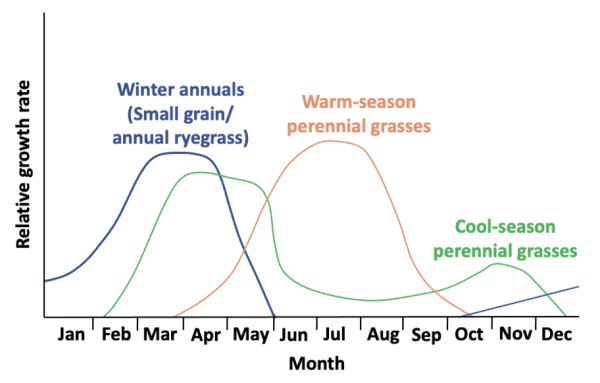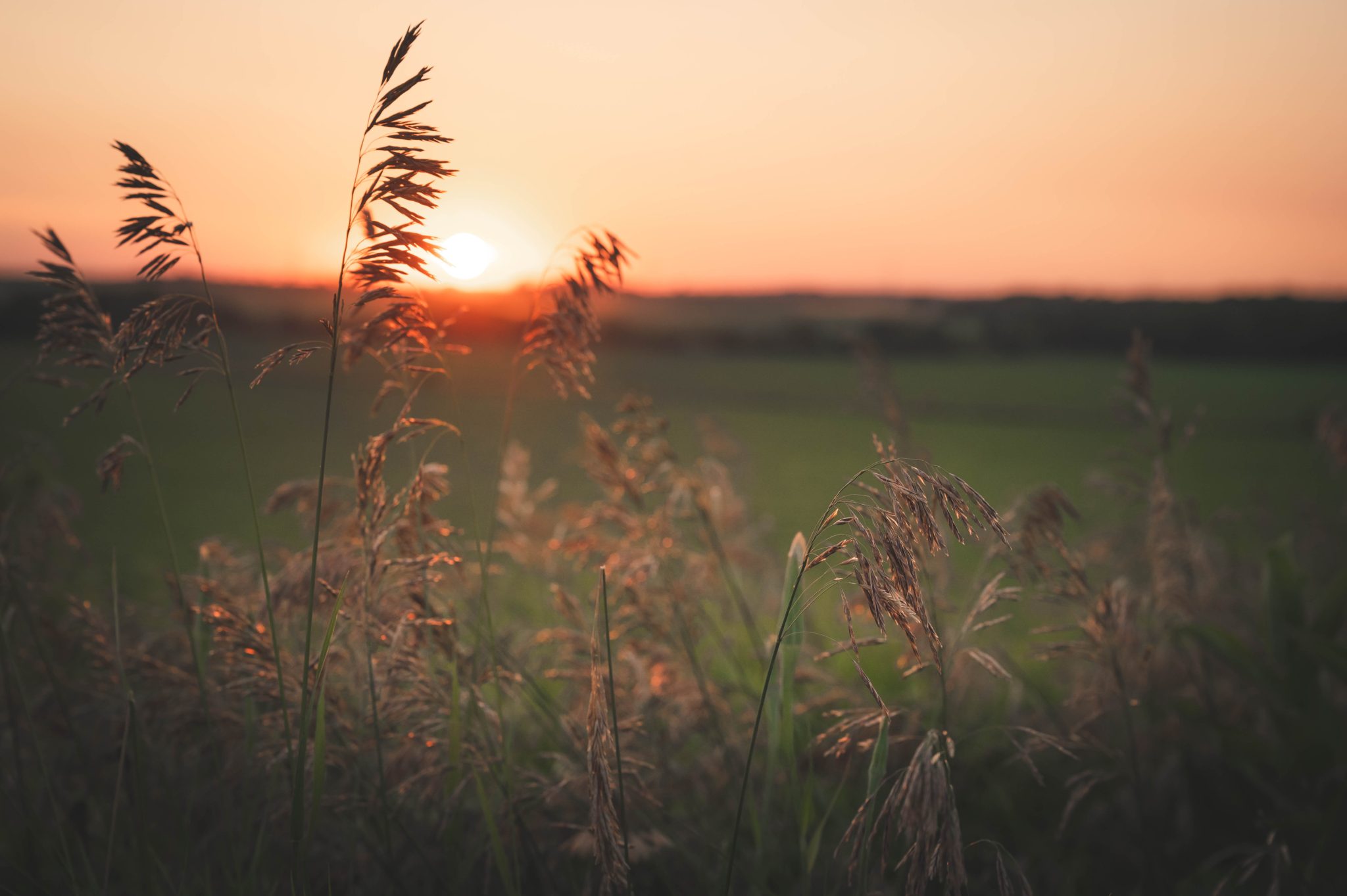Farming

Warm-season perennial pastures and hayfields are the base of about one-half of livestock production systems in Alabama. Bermudagrass and bahiagrass are the most common forages grown for warm-season yearly grass production in the state.

Figure 1. Seasonal forage production distribution for major categories of forages in Alabama.
The productivity of these forages fluctuates across the year due to the seasonality of forage production. These species are generally more productive from May to October. Their growth is reduced in late fall when these forages go dormant for the winter. Warm- season perennial grasses do not begin to regrow until temperatures warm again in the spring when soil temperatures consistently reach about 65 degrees F. The lack of forage for grazing during the winter often requires supplemental roughage and feedstuffs, increasing annual carrying costs in livestock systems. To overcome the shortage in forage production during this period, overseed warm-season perennial pastures and hayfields with cool-season annuals as an alternative to provide forage from late fall and early spring due to their complementary growth period (figure 1).
How do I overseed my warm-season perennial grass pastures or hayfields?
Warm-season grasses have a closed-plant canopy that is very competitive with emerging cool-season forage seedlings. Therefore, the success of overseeding relies initially on reducing vegetative cover or “thatch” to reduce competition and ensure good seed-soil contact. Among the practices to reduce vegetative cover of warm-season perennial grasses to establish overseeded pastures is implementing grazing, harvesting hay, or applying herbicides to induce a chemical frost. Although a common thought among farmers, reducing vegetative cover and overseeding warm-season pastures with cool- season annuals does not decrease the productivity of the perennial pasture in the following growing season.
What cool-season annuals can we use when overseeding warm-season perennial grasses?
Many cool-season annual forages can be overseeded in warm-season perennial grasses. See table 1 for information on seeding rate, depth, and planting dates for the cool-season forages recommended for overseeding warm-season perennial pastures.
Table 1. Planting Guide for Overseeding Warm-Season Perennial Pasture with Cool-Season Forages in Alabama
| Forage Species | Seeding Rate (lb/acre) - Alone | Seeding Rate (lb/acre) - Mixed | Seeding Depth (inches) |
|---|---|---|---|
| Barley | 100–120 | 60–75 | 1–2 |
| Oats | 90–120 | 60–90 | 1–2 |
| Rye | 9–120 | 60–90 | 1–2 |
| Triticale | 100–125 | 50–70 | 0.5 |
| Wheat | 90–120 | 60–90 | 1–2 |
| Annual ryegrass | 20–30 | 10–15 | 0–0.5 |
| Arrowleaf clover | 5–10 | 5–6 | 0–0.5 |
| Ball clover | 2–3 | 1–2 | 0–0.25 |
| Berseem clover | 20–25 | 10–15 | 0.25–0.5 |
| Crimson clover | 20–30 | 10–12 | 0.25–0.5 |
| Subterranean clover | 10–15 | 8–10 | 0.25–0.5 |
| Sweetclover | 12–15 | 8–12 | 0.25–0.5 |
Cool-Season Annual Grasses
Small grains (oats, rye, triticale, wheat) have high forage nutritive value. Cereal rye, wheat, and oat are the primary cool-season annual grasses used for overseeding warm-season perennial forages. Triticale is more widely recommended for silage, baleage, or hay production because of its slow regrowth when grazed. These cool-season forages are highly responsive to nitrogen fertilization and require adequate amounts of potassium and phosphorus for moderate to high forage production. Small grains provide forage production in the late fall and early winter months and generally mature by mid-spring.
Annual ryegrass is the most widely planted cool- season annual in Alabama. This forage is high in nutritional value, tolerant of moderate soil acidity, and responsive to nitrogen fertilization. Annual ryegrass is often confused with cereal rye. While both are cool- season annual grasses, they have very different growth habits. When ordering seeding, make sure that you order annual ryegrass not cereal rye. Annual ryegrass generally provides forage production from the late winter through spring. Do not overseed hay fields with annual ryegrass, as its late-season growth can reduce hay production early in the season. Each year Auburn University conducts annual ryegrass variety trials across multiple locations in Alabama. Find information on forage yield and nutritional value of annual ryegrass varieties using the Variety Selection Tool at the end of this document.
When comparing cool-season annual grasses, note cold tolerance, time to maturity, and yield potential. Find this information in table 2.
Table 2. Cool-Season Annual Grass Plant Cold Tolerance, Time to Maturity & Yield Characteristics
5 = Lowest cold tolerance, slowest time to maturity, and lowest yield
| Forage Species | Cold Tolerance | Maturity | Yield |
|---|---|---|---|
| Cereal Rye | 1 | 1 | 5 |
| Triticale | 2 | 2 | 4 |
| Wheat | 3 | 3 | 3 |
| Oats | 4 | 4 | 2 |
| Annual Ryegrass | 5 | 5 | 1 |
Cool-Season Annual Legumes
The additions of clovers to the overseeding mixture can help improve forage quality and add soil nitrogen to the perennial system. Clovers are a legume and can fix nitrogen as a result of a symbiotic relationship between the legume plant and the Rhizobium spp. bacteria. This action results in extra nitrogen in the soil, which can be available after the growth of the clover. This nitrogen is then available for use by warm-season perennial forages and can result in higher forage quality.
Arrowleaf clover can be overseeded in pastures and hayfields. This clover does not tolerate soil acidity and low fertility, and its optimum pH ranges between 5.8 and 6.5. It is responsive to potassium and phosphorus fertilization. Ball clover can be overseeded in pastures. It is more tolerant of soil acidity than crimson clover. Ball clover tolerates high grazing pressure. Berseem clover can be overseeded in pasture and hayfields. It has high nutritional value and rarely causes bloat. It requires high fertility, including boron. Grazing of berseem clover should initiate when stubble is 10 inches and maintained at 3 to 4 inches to encourage new plant growth. Crimson clover can be used in pastures and hayfields and is more productive at lower temperatures than other clovers. It tolerates soil acidity reasonably well and can be grazed throughout the winter. Red clover is recommended for grazing and hay production. When grazed, pastures should not be grazed closer than 3 inches. It grows best on soils with adequate fertility and optimum pH ranges between 6.2 and 6.5. Subterranean clover is a low-growing clover for grazing but can also be used in hayfields. It grows better under moderate to heavy grazing or close mowing. This clover is more tolerant of low fertility and shade than other clovers.
Brassicas
Forage brassicas are a common option for cool-season grazing. They are high in nutritional quality, and the large taproot of the plant can help reduce soil compaction. However, brassicas usually perform better when seeded into a conventionally tilled seedbed. When overseeded with a sod-forming perennial grass, the large taproot creates competition for root space, and the brassica has reduced yields. Because of this, brassicas are usually not recommended for use in overseeding warm-season perennial pastures.
Using Forage Mixtures for Overseeding
When overseeding perennial pastures and hayfields, it can also be useful to use mixtures of cool-season annual species. Planting a mixture of species can help extend forage production and quality during the cool-season relative to one species planted alone. It also adds species diversity to the forage system. Early-maturing forages can be paired with later-maturing types to extend forage growth from late fall/early winter through spring. Commonly planted mixtures often include small grains, annual ryegrass, and clovers in a two-way or three-way blend. When planting mixtures of cool-season annuals, refer to table 1 for seeding rate and planting depth recommendations when using blends.
Summary
Overseeding perennial pastures and hayfields can extend the grazing season and provide high-quality forages during a time of year when forages are generally limited. This can reduce the amount of supplemental roughage and feedstuffs a producer has to provide livestock during this time window. Also, because of the complementary growth patterns of cool-season annuals and warm-season perennials, warm-season perennial pastures and hayfields can be overseeded with the cool- season annuals. Overall, overseeding warm-season perennial pastures with cool-season legumes can be a good tool for producers who want to use land areas that are usually dormant in the winter to provide livestock with high-quality grazing opportunities.
 Peyton Zessin, Undergraduate Research Assistant, Animal Sciences; Carol Vasco, Postdoctoral Fellow, Animal Sciences and Forages; Josh Elmore, Regional Extension Agent, Animal Sciences and Forages; Kim Mullenix, Extension Specialist, Associate Professor, Animal Sciences and Forages; and Leanne Dillard, Extension Specialist, Assistant Professor, Animal Sciences and Forages, all with Auburn University
Peyton Zessin, Undergraduate Research Assistant, Animal Sciences; Carol Vasco, Postdoctoral Fellow, Animal Sciences and Forages; Josh Elmore, Regional Extension Agent, Animal Sciences and Forages; Kim Mullenix, Extension Specialist, Associate Professor, Animal Sciences and Forages; and Leanne Dillard, Extension Specialist, Assistant Professor, Animal Sciences and Forages, all with Auburn University
New October 2022, Overseeding Perennial Pastures & Hayfields with Cool-Season Annuals, ANR-2922

